Project Stages
Project Stages olcadminMost restoration projects can be broken down into separate sections from initial dismantling through to final reassembly and finishing. It is often possible to carry out some of these stages, on different parts or sub-assemblies of the mower, at the same time. For simplicity we will assume each section is completed before moving on to the next.
- Dismantling & Inspection
- Cleaning
- Painting
- Replacing Parts
- Reassembly
- Finishing
Cleaning Mowers
Cleaning Mowers olcadminRUST REMOVAL
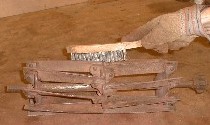
Rust is always a problem with steel or cast iron. You will need to remove it before you can repaint the mower.
Rust can be removed using a wire brush. Glass paper, sanding blocks and wire/steel wool are also useful. These all create dust so work in a well ventilated area if possible and wear a face mask to prevent breathing it in.
A wire brush wheel in a power hand drill can cut a lot of the effort out but can create even more dust. As with all power tools, take care and wear appropriate protection.
If you have access to shot blasting equipment this can make cleaning the components a lot easier. Shot blasting can clean the metal right back to a bare and clean surface. In reality it is not necessary to go this far.
Special chemicals can also be used to remove rust but there is no substitute for hard work with a wire brush.
You should be aiming for a surface free of loose rust and paint.
PAINT REMOVAL
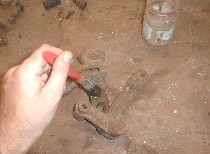
Even the rustiest machines will have some paint deposits on them.
There is a good case to be made for leaving original paint on the mower even if you are going to paint over it. In this way the original paint will be preserved for future inspection by historians, industrial archaeologists and enthusiasts may be able to use as yet unforeseen techniques to learn about the materials and skills of the past.
If you do decide to remove the paint, scraping is one of the simplest and best techniques, particularly for small areas. Scraping is also useful for larger areas but additional methods may be required. Paint stripper is useful. The water soluble, semi-gelatinous types are the best as they are easy to use and can be washed off afterwards.
Brush the stripper over the parts and leave for 15-30 minutes, using the time to work on other bits.
Once the paint is softened it can be removed more easily by scraping or wire brushing. A second or even third application is sometimes required.
Wipe cleaned parts with a rag soaked in white spirit to remove any stripper residues and leave to dry.
Remove remaining rust as previously described.
DEGREASING
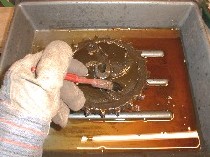
Some parts of the mower may be covered in oil or grease deposits. These need to be removed before the parts can be painted.
Heavy deposits can be scraped or wire brushed. After this, use special degreasing fluid to remove the remainder. Water washable is best.
For heavy deposits, soak parts in diesel oil followed by a final clean using degreaser.
When the parts are clean, remove any paint or rust as previously described.
If the parts will not require final painting (chains for example) store them safely until the mower is reassembled. A light coating of oil will help prevent new rust forming and will stop the components seizing while you work on the rest of the mower.
Rust forms quickly on bare iron and steel. When the parts are clean give them a coat of priming paint as soon as possible.
You are now ready to paint the mower.
Inspection & Dismantling
Inspection & Dismantling olcadminIt is easier to restore a mower if you dismantle it and work on each part separately.
You can then clean each part, put right any problems and repaint it before reassembly.
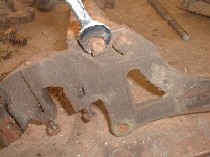
Here, the bottom blade is being removed from one of the side frames.
Most nuts and bolts should be reasonably easy to remove.
However, with old machinery, there is a good chance that some will be difficult to remove. Causes might include:
- parts corroded/rusted together
- damaged threads on nuts and/or bolts
- threads blocked by paint and/or rust
- components are out of shape
A closer look should reveal the cause of the problem.
SEIZED PARTS
Seized parts can present a potential problem. You need to free the part but you will not want to cause any unnecessary damage.
If you are having problems removing a seized part, be patient. There will be a great temptation to force a spanner or to hit the offending part with a hammer or some other tool get something to move. We have all been there and we have all probably regretted the ensuing damage.
Most problems can be solved by removing excess rust and paint from threads and by applying lubricating or penetrating oil.
For advice on some other common problems, see the special section on freeing seized parts.
On the Patent Chain Automaton the most serious problem was that the large sprocket on the rear roller was seized on to its shaft. The only way to get it off was to drill out the small metal key that holds the sprocket on to the shaft. A new key will be needed later.
The bottom blade was rusted beyond repair and will need replacing later. The holes on the sole plate for the mounting screws will need to be drilled out and retapped.
INSPECTION
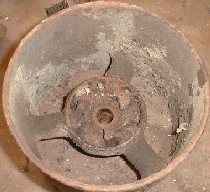
As you dismantle the mower, make a note of how the parts fit together and where any loose items such as springs and washers are placed. This image shows the rear roller and the location of the teeth that engage with the pawl on the main axle to drive the mechanism of the mower.

It is worth taking a photo of the components after you have finished dismantling the mower as a record.
Keep small items such as nuts and bolts in temporary containers. This prevent them becoming lost or rolling off the work space. Plastic trays for supermarket fruit and vegetables are ideal.
Painting & Finishing
Painting & Finishing olcadminPREPARATION
Painting is perhaps the most important stage of the restoration. It provides protection against corrosion and can give the mower that original look and feel that most collectors want to achieve.
The secret of good painting is preparation. When you have cleaned the parts and removed excess oil, grease and paint as described in the previous section you will be ready to start applying paint.
It is worth reading about choosing the right colours and where to find the right paint before you start.
Everyone has an opinion about the right way to paint old machinery. The method suggested here is suitable for virtually any old mower and does not require any special equipment.
All the paints can be applied by brush for simplicity. If you prefer to use a spray gun the general principles still apply.
USEFUL TIPS
Apply costs of paint thinly while making sure the item is properly covered. This will help prevent drips and runs in the paint. Some people like to rub down the paint between coats but this is not necessary unless the paint has been applied too thickly or has run and then dried to leave a mark. It is normally better to brush these runs out before the paint dries.
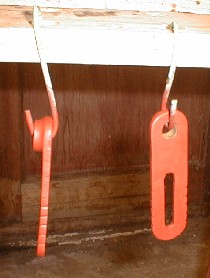
Cut up old wire coat hangers into various lengths and bend them into elongated S shaped hooks. These can be used to hang items up after painting while they dry. They can also be used during painting to support the item and prevent paint getting onto hands and gloves.
Small items such as nuts and bolts can be held in clothes pegs during painting and drying.
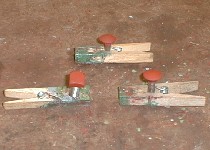
Make some jigs using pieces of wood and nails to support cumbersome items such as cutting cylinders.
Clean brushes out after use as directed on the paint tin. There is nothing worse than having to clean a brush before you can use it!
Wear gloves if only to keep messy paint off your hands.
PRIMING

Priming prepares the metal surface for additional coats of paint. Any good quality red-oxide type primer will provide the necessary "key" for further coats and give good protection against corrosion.
There is no need to use any of the extra special primers with additional anti-corrosion chemicals. These tend to be more expensive, harder to apply because they are more viscous and leave a thicker coat which is more prone to chipping.
Before you start decide if there are any areas that really do not need paint. For example, there is no need to apply paint in holes where shafts or bolts will pass. If you do paint them you will only need to clean them out afterwards.
Two thin coats of primer is more than adequate. Apply the paint with the brush as thinly as possible while making sure to cover the whole surface. Pay particular attention to working the paint into any pits in the metal surface and into any ridges and undulations, for example around cast lettering or other features.
Leave the parts to dry over night between each coat.
UNDERCOAT
Undercoat provides a suitable foundation for the final colour. It also provides a boundary between the primer and top coat so that fewer applications of the final colour are required.
One coat of undercoat is normally all that is required. A neutral colour such as grey is suitable for a wide range of greens and reds most often used for the final coats.

TOPCOAT
The topcoat provides the final colour of the mower. Most people use modern gloss paints because these are readily available. For older machines an "eggshell" type of paint may give a more authentic finish. It is really up to personal preference.
The coverage of modern paints is good enough that two thin coats of gloss is all that is required.

As with primer and undercoat, apply the paint sparingly while making sure to cover the entire surface. Leave to dry well between coats.
That is all there is to it. Some people add layers and layers of paint, rubbing carefully down between each, and then boast about their efforts. This is unnecessary. Even our two plus one plus two coats of primer, undercoat and gloss is much more than the original machines would have had but at least it provides a good standard of finish.
FINISHING
The final job when painting is to pick out any raised lettering. This is where you paint the lettering in a different colour to make it stand out.
It was often done on older mowers where manufacturer and model names are cast into handles, scraper plates or name badges.
Not all mowers had the lettering picked out but it should be possible to see if yours did during the inspection before you started the restoration. If there is evidence of a colour then you should use the same one when picking out.
If there is no evidence of picking out, there is no reason why you should not do it anyway. Popular colours include red, yellow and gold.
With care and a little practice it is perfectly possible to get good results using a small artists' brush. Some colours can also be applied using "painting pens" that can be bought in hobby and craft shops.